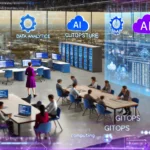In the ever-evolving landscape of artificial intelligence, one concept stands out as a beacon of innovation: how to train Reinforcement Learning agents. This dynamic approach to machine learning has gained immense traction, reshaping how we tackle complex challenges. Reinforcement learning, with its roots firmly planted in behavioral psychology, equips machines with the power to learn from their actions and refine their decisions. From mastering intricate games to orchestrating autonomous vehicles, the applications are boundless.
Imagine agents that learn by doing, navigating intricate mazes of data to unearth optimal solutions. This is where the magic of reinforcement learning comes alive. As we begin this adventure, this article promises to explain the intricacies and provide a strategy to train reinforcement learning agents efficiently. So buckle up as we enter the world of AI and real-life impact.
What is Reinforcement Learning
Reinforcement learning forms the heart of modern AI, a dance of concepts that orchestrates how machines learn through interaction. At the heart of reinforcement learning lies an ensemble of actors: the agents. These digital entities navigate within environments, which can be anything from virtual spaces to real-world scenarios. The driving force behind an agent’s actions is the pursuit of rewards, akin to the carrot on a stick. Rewards are the tangible consequences that agents seek to maximize as they journey through their learning experience.
Imagine an AI-driven dog training scenario. The dog, our agent, explores an array of environments like a park or a living room, responding to different cues. When it obeys commands or performs tricks, it receives treats or praise, which serve as rewards. As training progresses, the dog learns to associate specific actions with favorable outcomes, crafting a strategy to obtain the most rewards.
Reinforcement learning isn’t just about acquiring rewards; it’s about crafting intelligent decision-making. Agents, be they digital dogs or self-driving cars, learn to navigate their environments to accumulate maximum rewards over time. This process of mapping actions to outcomes isn’t mere memorization; it’s a journey towards optimal decision-making in dynamic and ever-changing landscapes.
Step-By-Step Guide on How to Train Reinforcement Learning Agents
# Lay the Groundwork
In the world of reinforcement learning, success begins with a sturdy foundation. Here we will learn about the essential groundwork that sets the stage for training resilient and effective agents.
Identify the Right Problem: Key Factors
- Complexity: Choose challenges that aren’t too simple, yet not overwhelmingly complex.
- Observable Feedback: Ensure the problem offers clear and measurable feedback.
- Iterative Learning: Opt for problems that allow agents to learn through repeated actions.
- Realism: Select scenarios that mirror real-world situations for practical application.
Prepare the Data: A Prerequisite for Learning
Before agents can embark on their learning journey, data preparation takes center stage. This involves curating datasets that provide a diverse range of scenarios and outcomes. Raw data often requires preprocessing to remove noise, standardize formats, and enhance its quality. Clean and structured data sets the tone for meaningful learning experiences, enabling agents to decipher patterns effectively.

# Algorithm Exploration
In the vast expanse of reinforcement learning, algorithms serve as the guiding stars that lead agents through the learning cosmos. Here we will navigate the constellation of algorithms, revealing their individual brilliance and the galaxies of problems they conquer.
A Spectrum of Algorithms: Q-learning, DDPG, PPO
Q-learning: A foundational algorithm that explores actions and learns optimal policies by iteratively updating action values.
DDPG (Deep Deterministic Policy Gradient): Tailored for continuous action spaces, DDPG refines policies using deterministic strategies.
PPO (Proximal Policy Optimization): Balancing stability and performance, PPO optimizes policies by limiting policy updates.
Algorithm Mechanisms and Applications
Q-learning: Imagine training a robot to navigate a maze. Q-learning equips it to take actions that maximize cumulative rewards, leading to efficient maze-solving.
DDPG: In scenarios like robotic arm control, DDPG learns precise actions to manipulate objects, demonstrating finesse in continuous control.
PPO: PPO shines in training agents for complex tasks like playing games, ensuring steady policy improvement without drastic deviations.
Choosing the right algorithm involves understanding your problem’s intricacies. For straightforward tasks with discrete actions, Q-learning is a reliable choice. In intricate continuous action spaces, DDPG’s grace comes to the forefront. Meanwhile, PPO’s versatility caters to domains demanding both stability and performance.
# Design the Training Strategy
Just as a conductor orchestrates a symphony, crafting a meticulous training strategy is key to molding proficient reinforcement learning agents. Training reinforcement learning agents is akin to coaching an athlete. We break down the journey into episodes, each encompassing a set of interactions with the environment. Within episodes, steps guide the agent’s actions, fostering incremental learning. This systematic breakdown ensures agents evolve in a controlled and progressive manner, gradually mastering the task at hand.
Hyperparameters are the dials that fine-tune the training process. Just as a chef adjusts ingredients for a perfect dish, tailoring hyperparameters is crucial for optimal agent performance. The learning rate, discount factor, and exploration rate are but a few of these dials. Context matters—every problem and algorithm requires a unique configuration, demanding a keen understanding of the intricacies to achieve the best results.
Strike the Balance: Exploration and Exploitation
A dance between exploration and exploitation underpins successful training. Imagine a chef exploring new ingredients while relying on familiar recipes. Similarly, agents must venture into uncharted territory to discover rewarding actions, all while leveraging their accumulated knowledge. Striking this balance ensures agents don’t get stuck in suboptimal solutions, paving the way for effective decision-making.
# Hands-On Training Execution
In this practical section, we roll up our sleeves and dive into the nitty-gritty of implementing the reinforcement learning training process. Get ready to translate theory into action and set your agents on the path to expertise.
How to Implement the Training Process
Initialization: Set up your coding environment with required libraries and dependencies.
Agent-Environment Interaction: Define agents and environments to establish the learning arena.
Action-Value Estimation: Employ algorithms to calculate action values based on agent experiences.
Policy Improvement: Update policies iteratively using chosen reinforcement learning methods.
Exploration Strategies: Incorporate exploration tactics to allow agents to discover new actions.
Convergence Monitoring: Track learning progress and halt when optimal performance is achieved.
The backbone of hands-on training lies in setting up the stage for agents’ learning odyssey. Create agents equipped with neural networks, defining their policies and strategies. Craft environments that encapsulate the problem’s dynamics, offering spaces for agents to explore and learn. Integrate chosen algorithms, such as Q-learning or DDPG, to govern learning and decision-making.
Practical Tips for Smooth Execution
Start Simple: Begin with basic environments and algorithms to grasp the implementation process.
Data Handling: Ensure proper handling of data to prevent issues like data leakage.
Hyperparameter Tuning: Experiment with hyperparameters to strike the right balance.
Monitor Progress: Keep track of rewards and learning curves to assess performance.
Debugging: Debug code meticulously to address errors and glitches promptly.
# Gauge Agent Proficiency
Evaluating the prowess of trained reinforcement learning agents is akin to scrutinizing a masterpiece. Crafting a robust evaluation plan is the cornerstone of assessing agent performance. This involves orchestrating scenarios that mirror real-world challenges. By exposing agents to diverse situations, you gauge their adaptability and ability to make optimal decisions in dynamic environments.
Metrics that Paint the Picture
- Cumulative Rewards: Sum up rewards over episodes to measure agent performance.
- Convergence Rates: Monitor how quickly agents converge to optimal solutions.
- Stability Analysis: Assess performance consistency across different scenarios.
- Learning Curves: Plot agent progress over time to visualize growth.
Overfitting, akin to memorization without understanding, can lead agents astray. To counter this, employ techniques like regularization, which curb over-optimization on training data. Generalization—applying learned behaviors to unseen scenarios—marks the hallmark of adept agents. Assess how well agents fare in unfamiliar territory, ensuring they don’t buckle under new challenges.
How to Overcome Training Hurdles
The path to training proficient reinforcement learning agents is rarely without its share of challenges. Here we will learn how to deal with them.
Identify Common Challenges
Training agents can be akin to solving puzzles – complex and unpredictable. Common challenges include:
Slow Convergence: Agents taking excessive time to reach optimal performance.
High Variance: Performance fluctuations hindering consistent learning.
Exploration Dilemma: Struggling to strike a balance between exploration and exploitation.
Hyperparameter Woes: Misconfigurations leading to suboptimal learning.
Strategies for Victory
Slow Convergence: Adjust learning rates, consider better exploration strategies, or try advanced algorithms like A3C.
High Variance: Employ techniques like experience replay to stabilize learning.
Exploration Dilemma: Gradually reduce exploration as learning progresses or experiment with alternative exploration techniques.
Hyperparameter Woes: Tweak hyperparameters incrementally, resort to grid search for systematic exploration.
Recognize that learning is an iterative process. Each challenge conquered, each stumbling block navigated, refines your understanding. Reinforcement learning mirrors life itself – a journey of trial, error, and gradual refinement. Problem-solving and adaptability drive success. Each setback illuminates a new facet of the problem, steering you closer to the ultimate solution.

Real-World Applications
The magic of reinforcement learning transcends the digital realm, extending its transformative touch across industries. Trained reinforcement learning agents have vaulted past theoretical realms, shaping tangible success stories. Consider the chessboard, where AI adversaries craft moves rivaling grandmasters. Witness autonomous vehicles deftly navigating complex traffic scenarios, or robots executing intricate surgeries with astounding precision. These triumphs attest to the limitless potential of reinforcement learning.
A Tapestry of Applications Across Industries
- Robotics: Agents guide robots in intricate tasks, from manufacturing to disaster response.
- Finance: Trained agents optimize trading strategies, tackling complex market dynamics.
- Gaming: AI opponents, powered by learned behaviors, heighten gaming experiences.
- Healthcare: Agents contribute to drug discovery, diagnosis, and personalized treatment plans.
Reinforcement learning isn’t just a tool; it’s a catalyst for innovation. Consider the algorithms behind recommendation systems, reshaping how we discover content. Imagine warehouses orchestrated by AI, optimizing logistics and minimizing costs. Trained agents redefine how we approach problems, infusing data-driven wisdom into conventional decision-making processes.
Conclusion
We’ve come to the final act of our adventure into the world of reinforcement learning, and the spotlight is on you. This field presents a large and unknown landscape of potential outcomes.
In this difficulty comes the excitement of exploration and the chance to affect the course of future events, therefore welcome it with open arms. The canvas is blank, waiting to be colored in whatever you see fit, be it by directing agents through virtual worlds, optimizing industrial processes, or making ground-breaking discoveries.
Always view setbacks as stepping stones to success, and use them as motivation to go outside the box. Adaptability and a willingness to try new things will serve you well on this journey. The actual potential of AI can only be realized if millions of lines of code, algorithms, and strategies are written, modified, and polished.
Make this guide your map, your inspiration, and your starting point. The process of pursuing your own reinforcing-learning goals is just as rewarding as the final product. By mastering the techniques of reinforcement learning, the future is yours to mold.
Learn more on how can Deep Learning models be trained.
References and Resources
For those eager to dive deeper into the world of reinforcement learning, here’s a curated collection of references and resources to fuel your quest for knowledge:
Research Papers
- Sutton, R. S., & Barto, A. G. (2018). “Reinforcement Learning: An Introduction.” MIT Press.
- Lillicrap, T. P., et al. (2016). “Continuous control with deep reinforcement learning.” arXiv preprint arXiv:1509.02971.
- Schulman, J., et al. (2017). “Proximal Policy Optimization Algorithms.” arXiv preprint arXiv:1707.06347.
Tutorials and Courses
- OpenAI’s Spinning Up in Deep RL: A comprehensive resource with practical tutorials and code samples.
https://spinningup.openai.com/
- Deep Reinforcement Learning Specialization on Coursera: A series of courses covering RL foundations and applications.
https://www.coursera.org/specializations/deep-reinforcement-learning
- Reinforcement Learning by David Silver: A series of video lectures by one of the pioneers in RL.
http://www0.cs.ucl.ac.uk/staff/d.silver/web/Teaching.html
Frameworks and Tools
- OpenAI Gym: A toolkit for developing and comparing RL algorithms using various environments.
- Stable Baselines3: A library providing high-quality implementations of reinforcement learning algorithms.
https://github.com/DLR-RM/stable-baselines3
- Ray RLlib: A distributed reinforcement learning library designed for both research and production.








